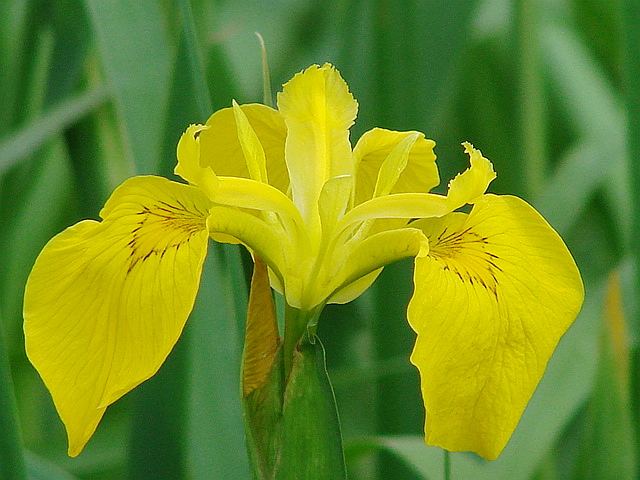Iris pseudacorus
Iris missouriensis
pale yellow iris
western blue flag, Rocky Mountain iris
Basal leaves stiff, narrowly linear, 5-9 dm. long and 10-15 mm. broad;
cauline leaves reduced upward.
Leaves basal, linear, 2-4 dm. long and 5-12 mm broad.
Inflorescence branched, few to several flowered, 1.5-5 dm. long;
flowers pale to deep yellow, purple-lined; pedicles up to 5 cm. long;
perianth parts fused in a tube at the base, the tube about about 12 mm. long;
sepals 3, obovate, spreading, about 5 cm. long;
petals 3, much shorter and narrower than the sepals, upright;
stamens 3, opposite the sepals;
style branches 3, about 22 mm. long, with 2 terminal lobes less than as long;
stigma triangular;
ovary inferior.
Flowers usually 2, pale to deep blue, purple-lined, subtended by a pair of involucral leaves;
pedicels stout, up to 6 cm. long;
perianth parts fused in a tube at the base, the tube 5-8 mm. long;
sepals 3, oblanceolate, 5-6 cm. long, spreading and reflexed;
petals 3, shorter and narrower than the sepals, erect;
stamens 3, opposite the sepals;
style branches 3, 20-25mm. long, with 2 terminal lobes about as long;
stigma broad and slightly notched;
ovary inferior.
Capsule 3-celled, leathery, 5-8 cm. long.
Capsule 3-celled, spindle-shaped, leathery, 3-5 cm. long.
Iris pseudacorus
Iris missouriensis
- Local floras:
BC,
CA,
OR,
WA
- Local Web sites:
CalFlora,
CalPhotos,
Flora NW,
PNW Herbaria,
Turner Photog.
WildflowerSearch
iNaturalist (observations)
USDA Plants Database
- LBJ Wildflower Center
- SEINet
- Plants of the World Online
- Encyclopedia of Life
- Wikipedia
- Google Image Search



